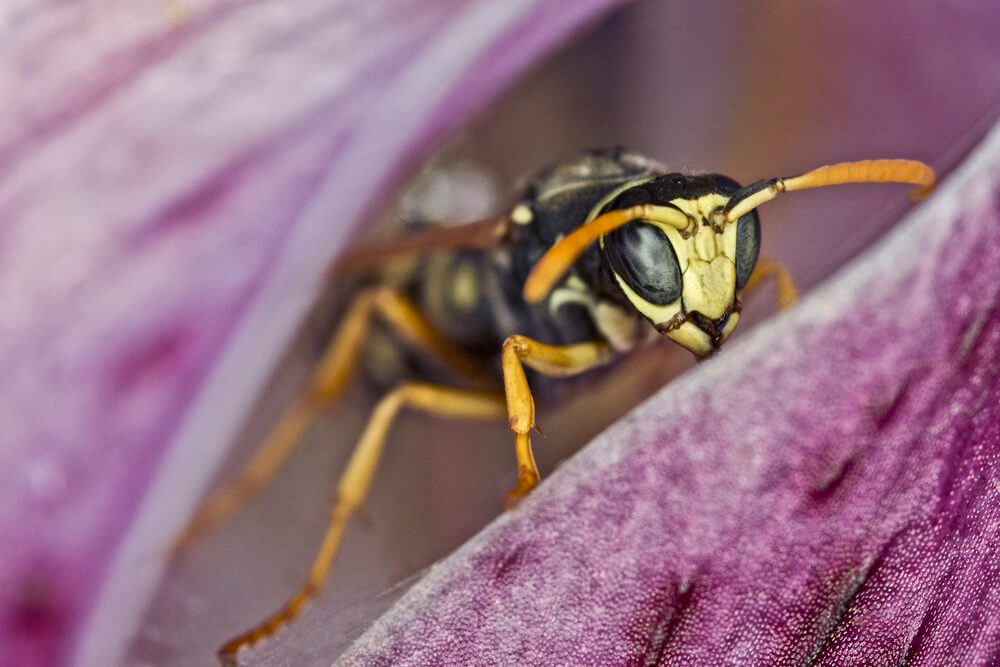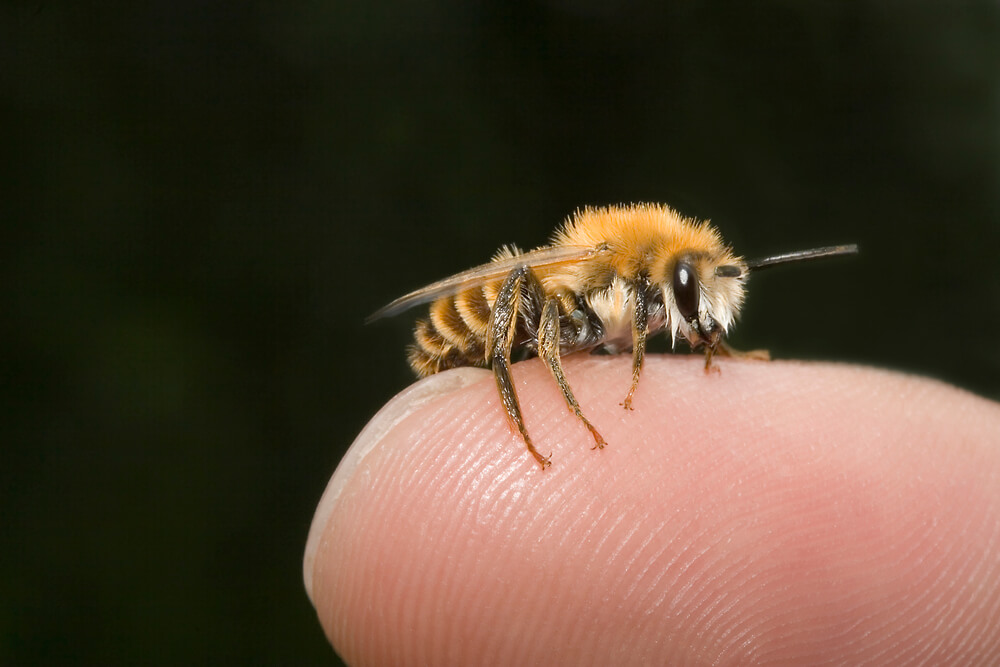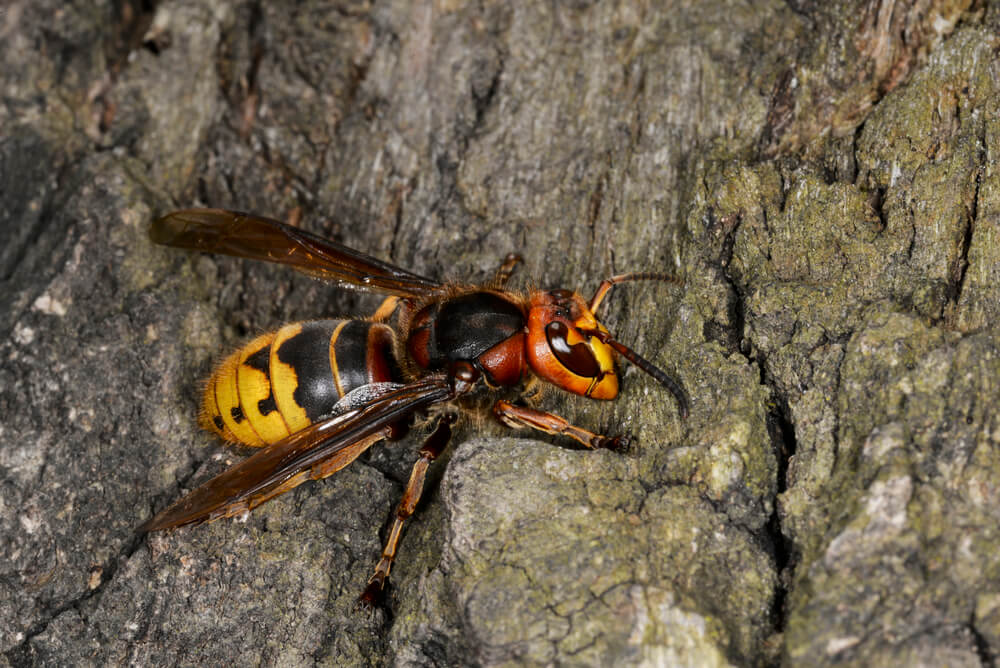Table of Contents:
Are Carpenter Bee Stings Dangerous?
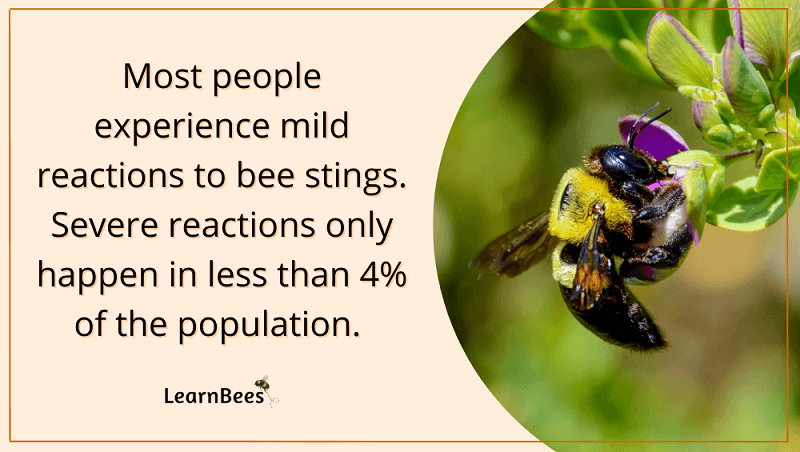
Carpenter bee stings are generally not dangerous unless you’re severely allergic to bee stings.
Most people experience mild reactions resulting in stinging, redness, and light swelling. These symptoms typically go away within 24 hours.
However, itching is a common symptom that can last several days.
Calamine lotion and hydrocortisone cream are good treatments for carpenter bee stings. They relieve itch and have antibacterial properties.(1, 2)
In rare cases, life-threatening allergic reactions can occur. This is known as anaphylaxis. The primary symptoms of a severe bee sting reaction are:(3)
- Difficulty breathing
- Trouble swallowing
- Hives
Anaphylaxis to carpenter bee stings usually starts within two hours of the sting.
But here’s the good news:
Less than four percent of adults are severely allergic to bee stings. Children are even less likely than adults to be severely allergic.(4, 5)
So, what does a carpenter bee sting look like?
It varies. There are three reactions to carpenter bee stings:
- Mild
- Moderate
- Severe
Let’s cover each one.
1. Mild Bee Sting Reaction (Most Common)
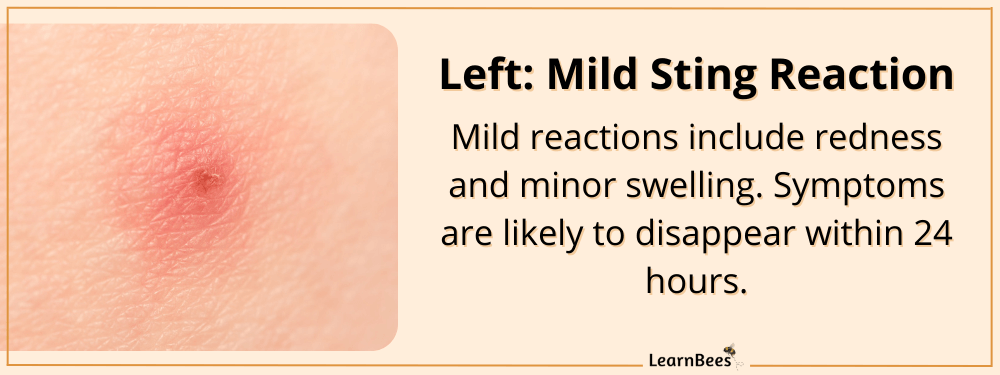
Most people have minor carpenter bee sting symptoms that include:
- Sharp burning pain at the sting site
- Itching
- A small, red welt at the sting site
- Minor swelling
2. Moderate Bee Sting Reaction (Less Common)
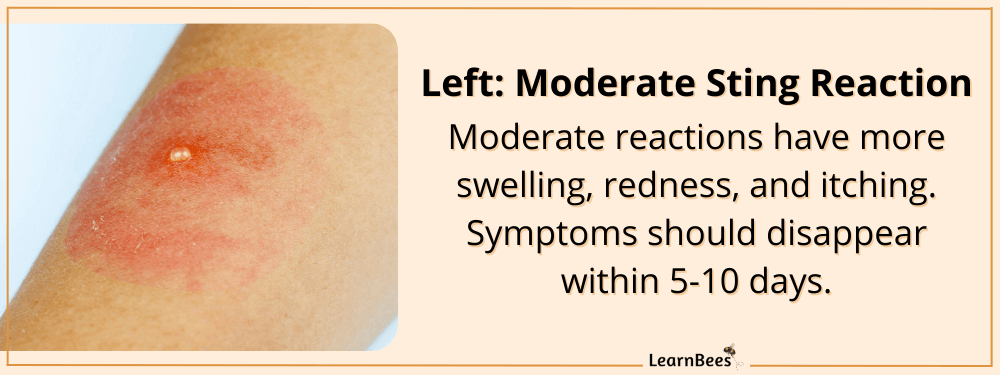
A few people may experience stronger carpenter bee sting symptoms, including:
- Prolonged redness
- Intense itching at the sting site
- Swelling around the sting that slowly enlarges over the next day or two
3. Severe Bee Sting Reaction (Very Rare)

A severe allergic response (anaphylaxis) to bee stings only occurs in a tiny percentage of individuals.
Signs of anaphylaxis include:
- A weak, rapid pulse
- Flushed skin, hives, or severe itching
- Difficulty breathing
- Swelling of the throat or tongue
- Vomiting, nausea, or diarrhea
- Dizziness or fainting
People with serious reactions should seek emergency treatment immediately.
How to Treat a Carpenter Bee Sting

For starters, begin by washing the area with soap and water to clean it.
It’s important to note:
Carpenter bees don’t leave their stinger behind like honey bees, so you don’t have to worry about removing it.
Next, use a cold compress like an ice pack to help soothe irritation. You can also take over-the-counter pain medication such as ibuprofen or acetaminophen if needed. For most, symptoms will significantly reduce or disappear entirely within 24 hours.(6)
However, itching is a common symptom that can last for several days.
We recommend applying hydrocortisone cream or calamine lotion to the affected area to reduce itching and irritation. These topical treatments are both antibacterial and anti-inflammatory, making them helpful to have in the medicine cabinet.(7, 8)
Severe bee sting reactions require immediate medical treatment.
Swelling in the mouth, trouble breathing, dizziness or nausea, and unconsciousness are serious symptoms of anaphylaxis. These severe reactions typically occur within two hours of the carpenter bee sting.(9, 10)
If you or someone you know displays these signs, call 911 or get medical help immediately. Additionally, if you’re prescribed epinephrine (EpiPen), use it as instructed by your doctor.
Do Female Carpenter Bees Sting?
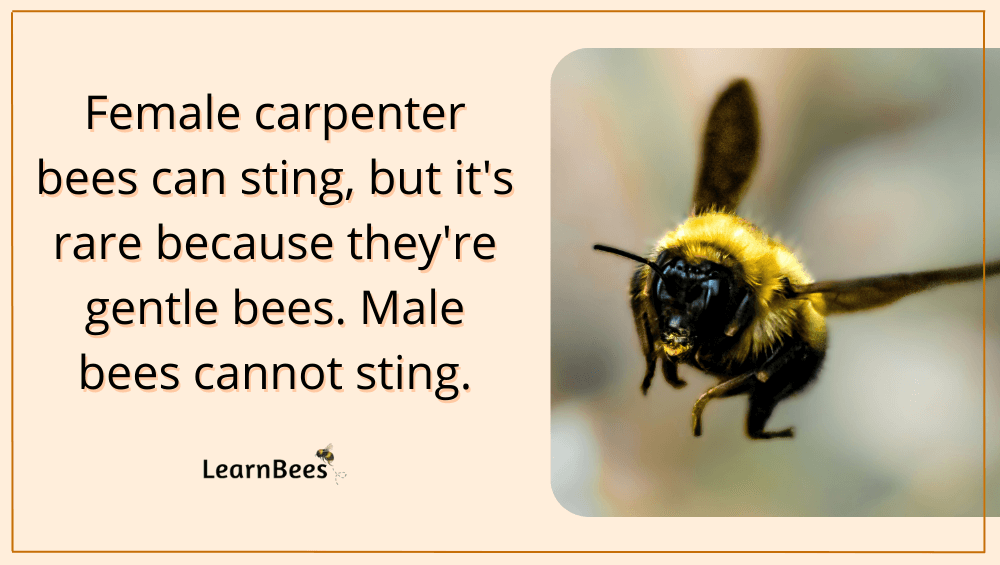
Female carpenter bees can sting, but it’s unlikely because they spend most of their time inside the nest.
Plus, carpenter bees are nicknamed the “gentle giants” of the bee world. They’re large bees that have a passive demeanor. Stinging is a last resort for them, only used when they feel directly threatened.
Better yet?
Most people only encounter male carpenter bees instead of females.
The good news is that male carpenter bees don’t have stingers, so they can’t sting. The same is true for other bee species and wasps.
Only females have stingers, while males do not.
However, male carpenter bees still like to “play tough” and pretend they will sting you. Male carpenter bees hover outside of the nest to protect it. When intruders come close, they’ll buzz around them quickly to scare them off.
This behavior usually works because most people don’t realize that male bees don’t sting.
If you have a carpenter bee buzzing around you, it’s best to walk away quickly. This gives the bee some space and helps deter them.
FAQs on “Are Carpenter Bee Stings Dangerous?”
- How painful is a carpenter bee sting?
- Do male carpenter bees sting?
- Is a carpenter bee sting harmful?
- Do carpenter bees have barbed stingers?
- What do you do if you get stung by a carpenter bee?
- Do carpenter bees stingers come out?
- Why do carpenter bees chase you?
- How do you stop a carpenter bee sting from throbbing?
How painful is a carpenter bee sting?
People frequently ask:
Why do carpenter bee stings hurt so much? Do carpenter bee stings hurt?
Carpenter bee stings hurt, but the pain isn’t unbearable for most. It feels like a slight pinch, like getting a doctor’s shot.
The carpenter bee sting pain index has a ranking of “2.” However, there are hundreds of carpenter bee species worldwide, so this can vary.
Dr. Justin O. Schmidt, an entomologist, created the Schmidt Sting Pain Index. This index aimed to rank how painful certain insect stings and bug bites were.
Dr. Schmidt spent over ten years as a test subject to various bug bites and stings. He measured everything from bees to ants to wasps. From there, he gradually assembled a scale of over 70 different stings, from the mildly irritating (0) to the excruciating (4).
Carpenter bee stings usually rank a “2” on the Schmidt Sting Pain Index. So they’re in the mid to low range of pain.
—> Go back to the FAQs on “Are Carpenter Bee Stings Dangerous?”
More to Explore:
- What Do Carpenter Bees Eat?
- Carpenter Bee vs. Bumble Bee: What’s the Difference?
- Do Carpenter Bees Pollinate?
Do male carpenter bees sting?
Male carpenter bees do not sting. They don’t have stingers, although they may seem threatening by flying around you.
A male carpenter bee’s threatening behavior is just a show they put on to deter predators from the nest. They may buzz around you rapidly and sometimes even bump into your head or body. However, they cannot sting.
Contrastly, female carpenter bees can sting. A sting from a female carpenter bee is rare because they spend most of their time foraging on flowers or nesting. Female carpenter bees aren’t aggressive and don’t try to sting people for no reason.
As long as you don’t poke your finger inside their nest, most people never have to worry about carpenter bee stings.
—> Go back to the FAQs on “Are Carpenter Bee Stings Dangerous?”
More to Explore:
Is a carpenter bee sting harmful? How serious are carpenter bee stings?
Carpenter bee stings can leave you with a mild stinging sensation that disappears within a few minutes. For most, carpenter bee stings aren’t that severe or painful. They can be treated at home with an antiseptic ointment or a cold compress.
Remember that carpenter bees don’t lose their stingers; they can sting multiple times if provoked. In some cases, this can cause minor swelling and irritation that lasts a few days.
However, there are some cases where carpenter bee stings can be more serious. For example, if a person is allergic to insect stings, they may experience anaphylaxis from a carpenter bee sting.
Signs of an allergic reaction to a carpenter bee sting include hives, swelling, difficulty breathing, and nausea. You should seek medical attention immediately if you experience any of these symptoms. Your doctor may prescribe an epinephrine injection in case of a severe allergic reaction.
—> Go back to the FAQs on “Are Carpenter Bee Stings Dangerous?”
More to Explore:
Do carpenter bees have barbed stingers?
Carpenter bees do not have barbed stingers. They have smooth stingers that allow them to sting multiple times without the stinger getting stuck in the skin. This means that, unlike honey bees, carpenter bees don’t die after stinging.
But carpenter bees are much less likely to sting than honey bees. Honey bees are defensive over their nest because they’re social bees that produce honey. Meanwhile, carpenter bees aren’t social bees and don’t produce honey.
They live mostly solitary lives, so you don’t have to worry about getting swarmed by hundreds of carpenter bees. Carpenter bees are also gentle-natured and rarely sting people. They will only sting if they feel threatened or provoked.
As long as you don’t stick your finger inside their nesting hole, then you should be fine.
—> Go back to the FAQs on “Are Carpenter Bee Stings Dangerous?”
More to Explore:
What do you do if you get stung by a carpenter bee?
If you get stung by a carpenter bee, you should cleanse the area thoroughly with soap and warm water. Washing the sting site can help prevent potential infection.
You don’t have to worry about removing a carpenter bee stinger. Unlike honey bees, carpenter bees don’t lose their stingers after stinging.
To relieve the pain and reduce swelling, apply a cold treatment like a frozen gel pack to the sting site. You can also take an antihistamine to reduce inflammation and itching.
If you encounter any indications of a serious allergic reaction, it is essential to seek medical attention immediately. These symptoms may include difficulty breathing, hives, vomiting, nausea, swelling in different parts of the body, and lightheadedness.
In severe cases, your doctor may also offer an epinephrine injection that will aid in alleviating symptoms from carpenter bee stings.
—> Go back to the FAQs on “Are Carpenter Bee Stings Dangerous?”
More to Explore:
- What Are Black and Yellow Wasps?
- How Long Do Bumble Bees Live?
- Honeybees vs. Bumblebees: How Do They Compare?
Do carpenter bees stingers come out?
Carpenter bee stingers do not come out of the carpenter bee, so you don’t have to worry about removing the stinger from your skin. This is because their stingers are smooth and not barbed.
This allows carpenter bees to sting you multiple times if provoked, so it’s essential to stay away from their nesting holes and not aggravate them.
That said, carpenter bees are docile insects that don’t typically sting unless threatened or provoked. As long as you keep your distance, you should be okay. It’s wise to be aware of carpenter bee nesting sites and don’t stick your face or hands too close to the area.
—> Go back to the FAQs on carpenter bee stingers
More to Explore:
- Wasps vs. Honey Bees: Are They Different?
- Are Worker Bees Male or Female?
- Queen Bee Versus Worker Bees – How Do They Compare?
Why do carpenter bees chase you?
Carpenter bees may chase you for short distances to get you to move away from their nests. If this occurs, then give the bee space and walk away.
Carpenter bees are not aggressive and generally won’t sting unless they feel in danger. For instance, I feel perfectly safe working in my flower beds while carpenter bees buzz around me. Since they’re not near their nest, they leave me alone because they have nothing to protect.
—> Go back to the FAQs on “Are Carpenter Bee Stings Dangerous?”
More to Explore:
How do you stop a carpenter bee sting from throbbing?
The best way to stop a carpenter bee sting from throbbing is to clean the sting site with soap and warm water. Then, apply a cold compress to reduce pain and swelling.
You can also take an oral pain reliever like ibuprofen or use a topical cream like hydrocortisone to reduce itching and inflammation. Most symptoms will disappear within 24 hours. Itching and stinging are normal reactions to a carpenter bee sting, so don’t be surprised if you experience them.
If the pain persists or your symptoms become worse, contact your doctor. They may prescribe a corticosteroid or antihistamine to help reduce the swelling and pain from the sting.
—> Go back to the FAQs on “Are Carpenter Bee Stings Dangerous?”

